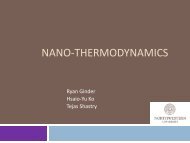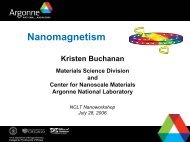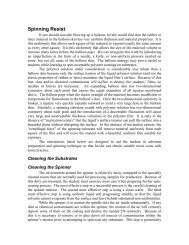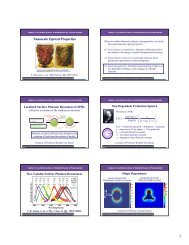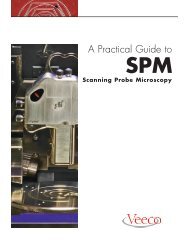II. Electron microscopy: TEM and SEM (PDF) - NCLT
II. Electron microscopy: TEM and SEM (PDF) - NCLT
II. Electron microscopy: TEM and SEM (PDF) - NCLT
You also want an ePaper? Increase the reach of your titles
YUMPU automatically turns print PDFs into web optimized ePapers that Google loves.
What can electrons do?<br />
Jian-Guo Zheng<br />
Materials Science & Engineering<br />
EPIC/NUANCE Center<br />
Northwestern University<br />
2220 Campus Drive, 1156 Cook Hall<br />
Evanston, IL 60208-3108, USA<br />
Phone: (847) 491-7807, Fax: (847) 491-7820<br />
E-mail: j-zheng3@northwestern.edu<br />
<strong>NCLT</strong>: June-Aug. 2006
What can electrons do?<br />
outline<br />
I. Introduction<br />
<strong>II</strong>. <strong>Electron</strong> <strong>microscopy</strong>: <strong>TEM</strong> <strong>and</strong> <strong>SEM</strong><br />
<strong>II</strong>I. Seeing with electrons: imaging<br />
IV. More than images<br />
V. Challenges <strong>and</strong> opportunities<br />
<strong>NCLT</strong>: June-Aug. 2006
<strong>II</strong> <strong>Electron</strong> <strong>microscopy</strong><br />
<strong>II</strong>.1 What are electron microscopes?<br />
<strong>II</strong>.2 Scanning electron microscope<br />
<strong>II</strong>.3 Transmission electron microscope<br />
<strong>NCLT</strong>: June-Aug. 2006
<strong>II</strong>.1 What are electron<br />
microscopes?<br />
• Definition<br />
• First (transmission) electron microscope<br />
• The brief history of electron <strong>microscopy</strong><br />
• Modern <strong>TEM</strong>s <strong>and</strong> <strong>SEM</strong>s<br />
• Major components of electron<br />
microscopes<br />
• <strong>Electron</strong> gun<br />
• <strong>Electron</strong> lens<br />
<strong>NCLT</strong>: June-Aug. 2006
<strong>II</strong>.1 What are electron<br />
microscopes?<br />
<strong>Electron</strong><br />
Microscopes are<br />
scientific<br />
instruments that<br />
use a beam of<br />
highly energetic<br />
electrons to<br />
examine objects<br />
on a very fine<br />
scale.<br />
<strong>Electron</strong> microscopes:<br />
scanning electron microscope (<strong>SEM</strong>) <strong>and</strong><br />
transmission electron microscope (<strong>TEM</strong>)<br />
e-beam<br />
Signals to <strong>SEM</strong><br />
Top<br />
Bottom<br />
specimen<br />
Signals to <strong>TEM</strong><br />
<strong>NCLT</strong>: June-Aug. 2006
1 st (Transmission) <strong>Electron</strong> Microscope<br />
1931 Max Knoll <strong>and</strong> Ernst Ruska built the first <strong>TEM</strong><br />
1986 Nobel prize for E.Ruska (together with G. Binning <strong>and</strong><br />
H. Rohrer, who developed the Scanning Tunneling Microscope)<br />
<strong>NCLT</strong>: June-Aug. 2006
Some Milestones in<br />
the History of <strong>Electron</strong> Microscopy<br />
1897 Discovery of the electron by J.J. Thompson<br />
1924 P. De Broglie: particle/wave dualism, magnetic<br />
coil/electron beam-glass/light<br />
1927 Hans Busch: <strong>Electron</strong> beams can be focused in an<br />
inhomogeneous magnetic field. <strong>Electron</strong> lens relation/ glass lens<br />
1931 Max Knoll <strong>and</strong> Ernst Ruska built the first <strong>TEM</strong><br />
1938 Scanning transmission electron microscope (M. von<br />
Ardenne)<br />
1939 First commercial <strong>TEM</strong> by Siemens (Ruska, von Borries)<br />
1943 <strong>Electron</strong> energy-loss spectroscopy EELS (J. Hillier)<br />
~1940 Basic theoretical work on electron optics <strong>and</strong> electron<br />
lenses (W. Glaser, O. Scherzer), Cs/Cc<br />
1951 X-ray spectroscopy<br />
<strong>NCLT</strong>:<br />
(R. Castaing)<br />
June-Aug. 2006
Some Milestones in<br />
the History of <strong>Electron</strong> Microscopy<br />
1956 First lattice image (J. Menter)<br />
1957 Multi-slice method (J. Cowley, A. Moodie)<br />
1964 First commercial <strong>SEM</strong> by Cambridge Instruments<br />
(Charles Oatley)<br />
~1970 HR<strong>TEM</strong> microscopes with a resolution better than 4 Å<br />
1986 Nobel prize for E.Ruska (together with G. Binning <strong>and</strong> H.<br />
Rohrer, who developed the Scanning Tunneling Microscope)<br />
1990: Aberration corrector design<br />
1998: first Cs-corrected transmission electron microscope<br />
2004: Cc/Cs corrected commercial electron microscope (JEOL,<br />
FEI, LEO…)<br />
<strong>NCLT</strong>: June-Aug. 2006
Modern <strong>TEM</strong>s<br />
High voltage <strong>TEM</strong><br />
JEOL 4000EX<br />
VG HB603<br />
JEM-2200FS<br />
<strong>NCLT</strong>: June-Aug. 2006<br />
Tecnai G2 F20 ST-twin
Modern <strong>SEM</strong>s<br />
Hitachi 4800<br />
LEO 1550<br />
FEI Quanta 600F<br />
JEOL 7700F<br />
1 st commercial<br />
AC-<strong>SEM</strong><br />
<strong>NCLT</strong>: June-Aug. 2006<br />
Strata 400<br />
FEI dual<br />
Beam<br />
(<strong>SEM</strong>/FIB)
Major components<br />
of electron microscopes<br />
• <strong>Electron</strong> source<br />
Light Source<br />
<strong>Electron</strong><br />
source<br />
• Illumination system<br />
• Specimen stage<br />
Condenser<br />
lens<br />
specimen<br />
Objective<br />
lens<br />
specimen<br />
lens<br />
Beam deflector<br />
• Imaging systems<br />
Projector<br />
lens<br />
Image<br />
on screen<br />
detector<br />
• Attachments<br />
Light<br />
Microscope<br />
<strong>TEM</strong><br />
<strong>SEM</strong><br />
EDS, EELS…<br />
Diagram from: http://www.mih.unibas.ch/Booklet/Lecture/Chapter1/Fig.1-6.gif<br />
<strong>NCLT</strong>: June-Aug. 2006
<strong>Electron</strong> Gun<br />
<strong>Electron</strong>s can be emitted<br />
from a filament (emitter or<br />
cathode) by gaining<br />
additional energy from heat<br />
or electric field.<br />
Commonly used emitters:<br />
Tungsten wire<br />
LaB6 filament<br />
Field emitter.<br />
Thermionic emission<br />
Field emission<br />
The common properties of<br />
the emitters are low work<br />
function, high melting point,<br />
<strong>and</strong> high mechanical<br />
strength<br />
W wire<br />
<strong>NCLT</strong>: June-Aug. 2006<br />
LaB6<br />
Field emitter
A comparison of electron sources<br />
<strong>NCLT</strong>: June-Aug. 2006
Electromagnetic Lens<br />
An electromagnetic lens can manipulate electron trajectory to form either a small<br />
electron probe (condenser) or an enlarged image of a specimen.<br />
If the image rotation is ignored, the behavior of the electromagnetic lens can be<br />
described by the formula used for optical lens: 1/f=1/p+1/q<br />
The focal length of the lens (f) can be changed by the electric current supplied to<br />
the lens (f α 1/(NI) 2 )<br />
Object<br />
Lens<br />
Image<br />
<strong>NCLT</strong>: June-Aug. 2006<br />
Picture from: http://www.matter.org.uk/tem/lenses/thin_lens_optics.htm
<strong>II</strong>.2 Scanning electron microscope<br />
• Signals <strong>and</strong> functions of a normal <strong>SEM</strong><br />
• How does <strong>SEM</strong> work?<br />
• Optimizing <strong>SEM</strong> Image<br />
• Interaction volume <strong>and</strong> resolution<br />
• Stigmatism <strong>and</strong> Resolution<br />
• Depth of Field<br />
• Secondary electron image- Topography<br />
• Backscattered electron image: Z-contrast<br />
• X-ray Energy Dispersive Spectroscopy (EDS) in<br />
<strong>SEM</strong><br />
• What else can we do in the <strong>SEM</strong>?<br />
<strong>NCLT</strong>: June-Aug. 2006
Signals <strong>and</strong> functions of a<br />
normal <strong>SEM</strong><br />
Secondary electrons<br />
Backscattered <strong>Electron</strong>s<br />
X-rays<br />
<strong>NCLT</strong>: June-Aug. 2006
How does <strong>SEM</strong> work?<br />
A <strong>SEM</strong> image is built up point by point, which is similar to TV, <strong>and</strong> the<br />
intensity of each pixel is proportional to the signal intensity.<br />
<strong>Electron</strong> gun generates an electron<br />
beam; (Condenser <strong>and</strong> objective)<br />
lens focuses the beam onto a<br />
sample; The beam deflector<br />
controls the beam scan onto the<br />
sample; At each point where the<br />
beam hits the sample,<br />
backscattered <strong>and</strong> secondary<br />
electrons are ejected from the<br />
specimen; Detectors collect these<br />
electrons, <strong>and</strong> convert them into a<br />
signal that is sent to a video screen.<br />
<strong>SEM</strong> Diagram<br />
<strong>Electron</strong><br />
gun<br />
Condenser<br />
lens<br />
Bean<br />
deflector<br />
Objective<br />
lens<br />
Specimen<br />
stage<br />
Detector<br />
<strong>NCLT</strong>: June-Aug. 2006
Scanning electron microscope<br />
Forming an<br />
electron probe<br />
source<br />
size do<br />
CL<br />
Beam scanning, beam/specimen<br />
Interaction <strong>and</strong> signal detection<br />
Beam scan<br />
Detector<br />
OL<br />
S<br />
specimen<br />
Signals<br />
Secondary electrons<br />
Backscattered electrons<br />
X-ray<br />
CL<br />
<strong>NCLT</strong>: Modified June-Aug. from: H:\2006research\nclt\<strong>SEM</strong>\<strong>SEM</strong>01.htm
Optimizing <strong>SEM</strong> Image<br />
•High resolution (ability to differentiate between small features on<br />
the surface: small probe diameter<br />
•Large depth of field (Ability for an image to be in focus over<br />
large changes in surface topography): a low convergence angle<br />
•High quality (ability to see details without interference from noise<br />
signal): high beam current<br />
An optimized <strong>SEM</strong> image is obtained through a control of the electron<br />
beam, that is, probe diameter, probe current <strong>and</strong> convergence angle,<br />
involving electron gun, condenser lens, objective aperture, <strong>and</strong><br />
working distance. A high resolution high quality image with a large<br />
depth of field is made by a beam with a high current <strong>and</strong> a low probe<br />
diameter <strong>and</strong> a low convergence angle. As the probe current is<br />
increased, both probe diameter <strong>and</strong> convergence angle increase. This<br />
is not desirable for imaging, so the parameters must be controlled in a<br />
way to produce the best mix of image quality, resolution, <strong>and</strong> depth of<br />
field depending on the features of interest on the sample itself.<br />
<strong>NCLT</strong>: June-Aug. 2006
Interaction volume <strong>and</strong> resolution<br />
The Scanning <strong>Electron</strong> Microscope (<strong>SEM</strong>) was developed mainly because of<br />
the limitations of optical <strong>microscopy</strong> (low resolution <strong>and</strong> poor depth of field).<br />
<strong>SEM</strong> resolution is<br />
dependent on the<br />
interaction volume resulted<br />
from the interaction<br />
between incident electrons<br />
<strong>and</strong> specimen. The<br />
interaction volume is<br />
associated with the beam<br />
size/shape, electron<br />
energy <strong>and</strong> specimen<br />
material.<br />
Please note: Small beam<br />
size may improve the<br />
resolution, but decrease<br />
the signal to noise ratio,<br />
that is, image quality or<br />
sensitivity.<br />
Resolution: Size/Shape of Interaction Volume<br />
Sensitivity: Signal/Noise Ratio<br />
It is necessary to make a balance between the<br />
resolution <strong>and</strong> sensitivity<br />
<strong>NCLT</strong>: June-Aug. 2006<br />
Interaction<br />
volume<br />
Diagram from: H:\2006research\nclt\<strong>SEM</strong>\<strong>SEM</strong>01.htm
Stigmatism <strong>and</strong> Resolution<br />
The shape of electron beam<br />
affects <strong>SEM</strong> image<br />
resolution: when the beam is<br />
round, or without stigmatism,<br />
the image shows small<br />
features (high resolution) as<br />
seen in Fig. a; when the<br />
beam is not round, or with<br />
stigmatism, the image<br />
details become vague (lower<br />
resolution) as seen in Fig. b.<br />
without stigmatism<br />
a<br />
1 µm<br />
c<br />
with stigmatism<br />
b<br />
1 µm<br />
d<br />
When the image has<br />
stigmatism, changing beam<br />
focus may result in elongated<br />
feature: Figs. c <strong>and</strong> d were<br />
recorded when the beam<br />
were under <strong>and</strong> over focus,<br />
respectively.<br />
1 µm<br />
1 µm<br />
Under focus<br />
Over focus<br />
<strong>NCLT</strong>: June-Aug. 2006<br />
Picture from: H:\2006research\nclt\<strong>SEM</strong>\<strong>SEM</strong>01.htm
Depth of Field<br />
The Scanning <strong>Electron</strong> Microscope (<strong>SEM</strong>) was developed mainly because of<br />
the limitations of optical <strong>microscopy</strong> (low resolution <strong>and</strong> poor depth of field).<br />
<strong>SEM</strong> image taken with secondary electrons (left) shows topographical features<br />
clearly. As compared with corresponding optical micrograph (right), the <strong>SEM</strong><br />
image shows three-dimensional appearance of the specimen image which is a<br />
direct result of the large depth of field (DOF) of the <strong>SEM</strong>, the biggest<br />
advantage.<br />
<strong>SEM</strong><br />
OM<br />
<strong>NCLT</strong>: June-Aug. 2006
Depth of field<br />
Depth of field (D) varies with the<br />
objective aperture size, working<br />
distance <strong>and</strong> magnification, <strong>and</strong> is<br />
given by the following expression:<br />
Depth of field (D)<br />
1<br />
D ∝ αM<br />
Where M is the magnification <strong>and</strong> α<br />
is the divergence angle which can<br />
be calculated from the aperture<br />
radius (RAp) <strong>and</strong> working distance<br />
(DW):<br />
α = R Ap<br />
D W<br />
<strong>SEM</strong>: small α<br />
Optical microscope: large α<br />
Depth of field (D) is the height over<br />
which the sample can be clearly<br />
focused.<br />
<strong>NCLT</strong>: June-Aug. 2006
Secondary electron image-<br />
Topography<br />
SE contrast mechanism: Edge effect<br />
SE image of Al2O3/Ni<br />
Secondary electrons escape from sample areas close to the surface. The edge effect takes<br />
place when many electrons escape from areas with sharp edges or peaks to be deflected by<br />
the Faraday Cage (B). Some electrons escape from areas without sharp edges (A <strong>and</strong> C). Few<br />
secondary electrons are detected when generated secondary electrons are only deflected<br />
partially by the Faraday Cage due to the location on the sample they are generated (A).<br />
<strong>NCLT</strong>: June-Aug. 2006<br />
Picture: Courtesy of Prof. T. Sekino, ISIR, Osaka Univ.<br />
Diagram from: H:\2006research\nclt\<strong>SEM</strong>\<strong>SEM</strong>01.htm
Backscattered electron images:<br />
Z-contrast<br />
In BSE image, the signal is dependent on atomic number<br />
In BSE image, Ni precipitates is much brighter than Al2O3; as<br />
comparison, In SE image, Ni <strong>and</strong> Al2O3 have similar contrast<br />
Backscattered electron (BSE) image Secondary electron (SE) image<br />
BSE<br />
SE<br />
Al2O3/Ni composite<br />
Courtesy of Prof. T. Sekino, ISIR, Osaka Univ.<br />
<strong>NCLT</strong>: June-Aug. 2006
X-ray Energy Dispersive<br />
Spectroscopy (EDS) in <strong>SEM</strong><br />
RGB<br />
EDS spectrum: Characteristic X-ray peaks on continuum bk<br />
http://www.geosci.ipfw.edu/cgi-bin/sem/techinfo.cgi?choice=xmap<br />
<strong>NCLT</strong>: June-Aug. 2006<br />
EDS elemental maps
What else can we do in the <strong>SEM</strong>?<br />
•High Resolution <strong>SEM</strong><br />
•Low kV imaging<br />
•S<strong>TEM</strong><br />
•Stereo<strong>microscopy</strong><br />
•Voltage contrast<br />
•Magnetic field contrast<br />
•Crystallographic contrast<br />
•<strong>Electron</strong> channeling diffraction<br />
•<strong>Electron</strong> backscattered diffraction (EBSD)<br />
•Cathodluminiscence (CL)<br />
•E-beam lithography<br />
<strong>NCLT</strong>: June-Aug. 2006
<strong>II</strong>.3 Transmission <strong>Electron</strong><br />
Microscopy (<strong>TEM</strong>)<br />
• Signals <strong>and</strong> Functions of Modern <strong>TEM</strong>s<br />
• An example: ASTAR <strong>TEM</strong> @ EPIC<br />
• Basic <strong>TEM</strong> diagram<br />
• Illumination system<br />
• Imaging system<br />
• Basic <strong>TEM</strong>: Image <strong>and</strong> Diffraction<br />
• <strong>TEM</strong> Imaging: mass-thickness contrast, diffraction contrast, phase contrast<br />
• <strong>TEM</strong> diffraction: SAED & CBED<br />
• X-ray Energy Dispersive Spectroscopy (EDS)<br />
• <strong>Electron</strong> Energy Loss Spectroscopy (EELS)<br />
• Energy-filtered <strong>TEM</strong><br />
• EF<strong>TEM</strong> spectrum imaging<br />
• Scanning Transmission <strong>Electron</strong> Microscopy (S<strong>TEM</strong>): BF/ADF<br />
• S<strong>TEM</strong>: HAADF Z-contrast<br />
• S<strong>TEM</strong>: EDS <strong>and</strong> EELS<br />
• Other <strong>TEM</strong> techniques<br />
<strong>NCLT</strong>: June-Aug. 2006
Signals <strong>and</strong> Functions of<br />
Modern <strong>TEM</strong>s<br />
Incident electrons<br />
X-ray<br />
specimen<br />
Imaging<br />
Diffraction<br />
Inelastically<br />
scattered<br />
electrons<br />
Transmitted<br />
electrons<br />
Elastically<br />
scattered<br />
electrons<br />
<strong>NCLT</strong>: June-Aug. 2006<br />
Spectroscopy<br />
Spectrum imaging
For example: ASTAR <strong>TEM</strong> @ EPIC Northwestern University:<br />
Analytical Scanning Transmission Atomic Resolution<br />
JEOL 2100F (S)<strong>TEM</strong><br />
High Voltage: 200kV,<br />
Gun: Schottky FEG emitter<br />
Pole piece: Ultra high resolution<br />
Stages: Double tilt, Single tilt<br />
Camera: Film/TV rate CCD/Slow<br />
scan CCD<br />
Attachments: Oxford EDS,<br />
GIFTridiem, BF/ADF/HAADF<br />
S<strong>TEM</strong><br />
Functions: BF/DF, HR<strong>TEM</strong>,<br />
S<strong>TEM</strong>, CBED, Nanodiffraction,<br />
PEELS, EDS, EF<strong>TEM</strong>, Z-Contrast<br />
Imaging<br />
Lattice resolution: 0.1 nm<br />
Point resolution: 0.19 nm<br />
S<strong>TEM</strong> spot: 0.136 nm<br />
Sub-nano-analysis: 0.2 nm-0.5 nm<br />
Cs=0.5 mm<br />
Cc=1.1mm<br />
Sample tilt: 25°<br />
Environment is important to achieve high<br />
performance !<br />
<strong>NCLT</strong>: June-Aug. 2006
Basic <strong>TEM</strong> diagram<br />
Gun<br />
Illumination system<br />
Specimen<br />
Imaging system<br />
CL<br />
CA<br />
SP<br />
OL(OA)<br />
SA<br />
IL<br />
PL<br />
S<br />
<strong>NCLT</strong>: June-Aug. 2006
Illumination system<br />
Gun<br />
crossover<br />
Condenser<br />
Lens 1<br />
Condenser<br />
Lens 2<br />
Upper<br />
Objective<br />
Lens<br />
Specimen<br />
Parallel beam<br />
<strong>NCLT</strong>: June-Aug. 2006<br />
Convergent beam
Imaging system<br />
Specimen<br />
Diffraction pattern<br />
Image<br />
Intermediate<br />
Lens<br />
Projector<br />
Screen<br />
Diffraction<br />
<strong>NCLT</strong>: June-Aug. 2006<br />
Image
Basic <strong>TEM</strong>:<br />
Image <strong>and</strong> Diffraction<br />
Thin specimen
<strong>TEM</strong> Imaging: Mass-thickness<br />
BF <strong>TEM</strong><br />
image of<br />
silica:<br />
Thickness<br />
contrast<br />
<strong>TEM</strong> Contrast<br />
mechanisms:<br />
Amorphous material<br />
SiO2<br />
•Mass-thickness<br />
•Diffraction contrast<br />
•Phase contrast<br />
Thickness map: EELS<br />
<strong>NCLT</strong>: June-Aug. 2006
BF <strong>TEM</strong><br />
YBaCuO stacking faults<br />
<strong>TEM</strong> Imaging:<br />
Diffraction Contrast<br />
Defects<br />
Phase<br />
Strain fields<br />
g<br />
DF <strong>TEM</strong><br />
TiAl lamellar structure<br />
BF image<br />
<strong>NCLT</strong>: June-Aug. 2006<br />
DF image
High Resolution <strong>TEM</strong><br />
Growth twin in SnO2<br />
<strong>TEM</strong> imaging:<br />
Phase contrast<br />
Interference pattern of<br />
diffraction beams<br />
•Crystal structure<br />
•Defect<br />
Journal of Applied Physics,<br />
79 (10): 7688-7694 May 15 1996<br />
<strong>NCLT</strong>: June-Aug. 2006
Diffraction: SAED<br />
Selected Area <strong>Electron</strong> Diffraction<br />
--crystal structure, orientation relationship<br />
SAED<br />
SAED pattern: CdO/MgO<br />
BF <strong>TEM</strong><br />
g=200<br />
Parallel<br />
electron<br />
beam<br />
CdO Film<br />
Cubic/cubic<br />
MgO substrate<br />
__<br />
200 nm<br />
J. Am. Chem. Soc., Vol 126 (27), 8477-8492, 2004<br />
<strong>NCLT</strong>: June-Aug. 2006
Diffraction: CBED<br />
Crystal symmetry<br />
precipitate<br />
Point group<br />
Convergent beam<br />
sample<br />
Phil. Mag. A, 80 (2): 493-500 Feb 2000<br />
<strong>NCLT</strong>: June-Aug. 2006
Spectroscopy <strong>and</strong><br />
Spectrum Imaging<br />
•EDS<br />
• EELS<br />
<strong>NCLT</strong>: June-Aug. 2006
X-ray Energy Dispersive<br />
Spectroscopy (EDS)<br />
EDS:<br />
•Composition information<br />
•Easy to operate the system<br />
•Convenient to identify<br />
elements<br />
•Good for elements with<br />
higher atomic number<br />
•Complementary to EELS<br />
•Low background<br />
For S<strong>TEM</strong>:<br />
•High spatial resolution<br />
•Low signal (counts)<br />
•FEG gun needed<br />
Operation modes:<br />
•Spot<br />
•Line scan<br />
•mapping<br />
<strong>Electron</strong> probe<br />
X-ray<br />
Thin sample<br />
a<br />
b<br />
ADF S<strong>TEM</strong> image<br />
<strong>NCLT</strong>: (I nm probe) June-Aug. 2006<br />
EDS spectra from a) ZnO tetrapod<br />
<strong>and</strong> b) CuO particles. Ni signal is<br />
from Ni supporting grid.<br />
O<br />
O<br />
Zn<br />
Cu<br />
Ni<br />
Ni<br />
Cu<br />
Zn<br />
Zn<br />
Cu<br />
a<br />
b
<strong>Electron</strong> Energy Loss<br />
Spectroscopy<br />
•EELS signals reflect elemental concentration<br />
•EELS adds another dimension for generating <strong>TEM</strong><br />
image contrast<br />
•EELS signal can be used to rapidly identify <strong>and</strong> map<br />
elements <strong>and</strong> phases<br />
•EELS isolates pure elastic signal for quantitative<br />
imaging <strong>and</strong> diffraction<br />
•EELS provides information about electronic<br />
structure <strong>and</strong> properties<br />
What does an EELS spectrum look like?<br />
Two types of Energy Filter<br />
<strong>NCLT</strong>: June-Aug. 2006<br />
Diagram of EELS<br />
Courtesy:Dr. Mike Kundmann, Gatan
PEELS spectra from ZnO tetrapod <strong>and</strong> CuO particles<br />
•<strong>TEM</strong><br />
•S<strong>TEM</strong><br />
ZnO<br />
CuO<br />
O-K edge<br />
Zn L23 edge<br />
1020 eV<br />
O-K edge<br />
Cu L23 edge<br />
931 eV<br />
<strong>NCLT</strong>: June-Aug. 2006
Energy-filtered <strong>TEM</strong>: elemental-specific imaging<br />
EELS elemental map: three-window method<br />
Pre-edge 1 Pre-edge 2 Post-edge<br />
Cu-L23<br />
Cupper Map<br />
<strong>NCLT</strong>: June-Aug. 2006
EF<strong>TEM</strong> spectrum imaging<br />
•3D data set is built up image by image<br />
ZnO-CuO<br />
Cu-L edge<br />
Zn-L edge<br />
<strong>NCLT</strong>: June-Aug. 2006
Scanning Transmission <strong>Electron</strong><br />
Microscopy (S<strong>TEM</strong>)<br />
S<strong>TEM</strong>: BF/ADF<br />
S<strong>TEM</strong> diagram<br />
Au/Ag nanoparticles<br />
BF S<strong>TEM</strong><br />
ADF S<strong>TEM</strong><br />
Annular Dark<br />
field detector<br />
Bright field<br />
detector<br />
Compare with <strong>TEM</strong>:<br />
-BF: Similar<br />
-DF: More efficient<br />
Detector ring/ aperture (<strong>TEM</strong>)<br />
<strong>NCLT</strong>: June-Aug. 2006<br />
Advanced Materials, 12 (9): 640-643, May 3 2000
S<strong>TEM</strong>: HAADF Z-contrast<br />
-Actual atomic position<br />
-Contrast changing with Z<br />
-Small probe for analysis<br />
Ge/Si<br />
Si Dumb-Bell<br />
0.136 nm<br />
S<strong>TEM</strong> of Si [110]<br />
Advantage: HAADF S<strong>TEM</strong> image vs. HR<strong>TEM</strong><br />
<strong>NCLT</strong>: June-Aug. 2006
S<strong>TEM</strong>: EDS <strong>and</strong> EELS<br />
Spectrum: spot, line, area<br />
Spectrum imaging<br />
<strong>NCLT</strong>: June-Aug. 2006
Other <strong>TEM</strong> techniques<br />
• Lorentz <strong>microscopy</strong><br />
• Reflection electron <strong>microscopy</strong><br />
• <strong>Electron</strong> holography<br />
•Cryo-<strong>TEM</strong><br />
• In-situ <strong>TEM</strong><br />
• <strong>TEM</strong> tomography<br />
•…<br />
<strong>NCLT</strong>: June-Aug. 2006



